kids handicap accessbile garden bed: Create Inclusive Gardening Spaces for All Ages.
kids handicap accessbile garden bed: Creating inclusive gardening spaces is key for everyone to enjoy gardening. It means designing gardens without barriers, so all can participate fully. Wide pathways, at least 4 feet, and better at 5 feet, help wheelchair users and others move easily.
Accessible raised garden beds are great for all, with heights that are comfortable for both kids and adults. Seating areas throughout the garden offer places to rest and think
Accessible garden tools, like those with padded handles and bright colors, make gardening fun for everyone. Wind chimes and textured pathways help those with visual impairments, making the garden welcoming for all. Schools with limited resources can use adaptive tools and vertical gardening. Adding different textures and smells makes the garden a richer experience for everyone.
Working together to make gardens accessible promotes inclusivity and community. It helps people of all abilities come together, building stronger community bonds.
What is a Kids kids handicap accessbile garden bed?
A kids handicap accessible garden bed is made for kids who have trouble moving around. It’s built high so kids in wheelchairs or with mobility issues can garden easily. These beds help kids feel independent and excited about gardening.
They have special designs that make gardening fun and easy. Kids can plant, care for, and pick their own food without getting tired. This makes gardening a fun and rewarding activity for everyone.
These garden beds do more than just help kids. They let kids connect with nature, learn to be responsible, and grow as individuals. Gardening is full of sensory experiences that spark creativity and build community among kids, no matter their abilities.
By investing in these garden beds, we support inclusive and caring gardening spaces. This effort is part of a bigger push to include everyone in community activities. It improves life quality and brings people together, helping both those with disabilities and the whole community.
Benefits of Wheelchair Accessible Raised Garden Beds
Wheelchair accessible raised garden beds offer big benefits for kids and adults with disabilities. About 33 percent of adults in Mississippi have a disability, showing the need for gardening solutions that include everyone. These beds make gardening fun for everyone, letting wheelchair users garden with their friends.
They are made to be easy to use, with widths of 3–4 feet and heights from 8–12 inches to 2–3 feet. This meets different mobility needs.
Gardening in these beds is good for the body and mind. It helps improve focus and learning skills. It also helps people talk more, building a supportive community for those with disabilities.
Plus, raised beds drain better and warm up faster in spring. This means gardeners can grow more food.
Putting these beds in schools, community gardens, and homes shows a real commitment to including everyone in gardening. It’s also important to make sure gardening is safe, especially in bad weather and with tools that fit everyone’s needs.
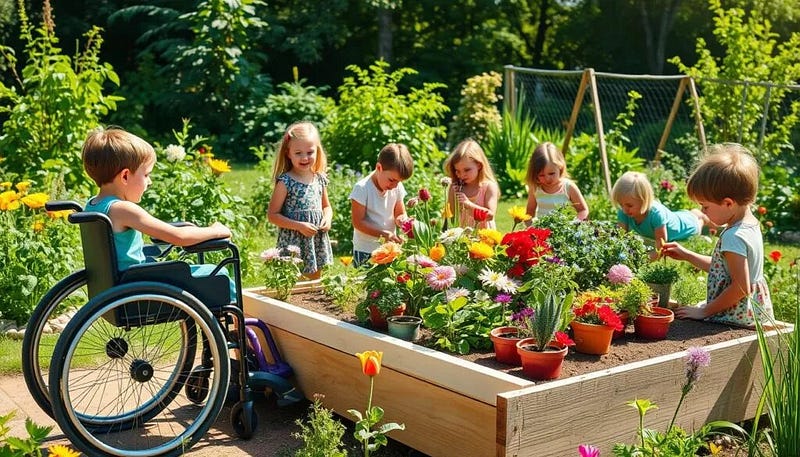
Design Features of a Wheelchair Accessible Garden Bed
The design of a wheelchair accessible garden bed should focus on user comfort and functionality. Key features include:
- Lower Height: This enables wheelchair users to reach their gardening space without strain.
- Wide Frame: A frame that allows for easy maneuverability, making it simpler to transition from a wheelchair to the garden bed.
- Ergonomic Supports: Built-in supports can aid in maintaining stability while reaching for plants.
- Non-Slip Surfaces: Materials that prevent slipping ensure safety, especially in wet conditions.
- Durable Materials: Utilizing weather-resistant materials prolongs the lifespan of garden beds.
Constructing wheelchair accessible garden beds can incorporate various materials tailored to specific needs. For example:
Integration of features such as handrails between 76cm and 94cm in height can significantly enhance safety and support. Adding options like hi-lo systems for hanging baskets can also cater to users with limited mobility, enabling easier access for plant maintenance. Thoughtful design not only opens gardening opportunities for individuals with disabilities but also contributes to an inclusive environment for all levels of ability.
Modular Designs for Customizable Gardening Spaces
Creating a welcoming garden space means using new designs. Modular raised garden beds let you tailor your area to fit your needs. For example, beds for wheelchair users are often 36 inches tall and 25 inches wide, making them easy to access.
Companies like Birdies offer a range of modular, rounded steel beds. They come in various heights and sizes to meet different needs while making your garden look great. Systems like WoodBlocX are easy to set up and customize, making gardening more accessible for everyone and.
You can design your garden in many ways, like U-shaped or H-shaped beds. These layouts offer space for workstations and are wheelchair-friendly. You can even add seating to planters for more comfort and ease.
Many modular systems also have self-irrigation features. This cuts down on upkeep and makes caring for your plants easier, so you can enjoy your garden more. Modular designs are versatile and accessible, perfect for anyone wanting a welcoming garden space.
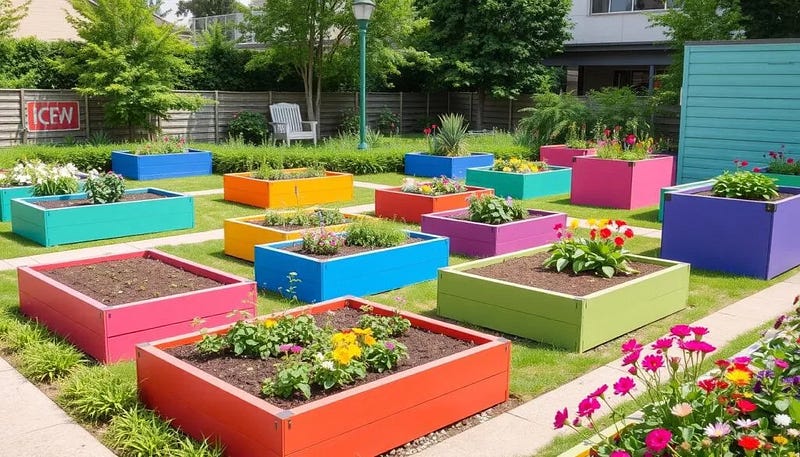
How to Create Paths for Wheelchair Accessibility
Creating paths for wheelchair users is key to making gardens inclusive. It’s important to think about the size and materials used. This way, everyone can enjoy gardening without any barriers.
Dimensions and Materials for Accessible Paths
Paths should be at least 5 feet wide. This allows for wheelchairs, turns, and gardening tools. It also gives enough room for users and their friends.
Using strong materials like concrete, asphalt, or decomposed granite is important. Concrete can last up to 50 years, while asphalt lasts about 30 years. Curved paths are better than sharp corners for wheelchair users.
It’s also vital to have proper drainage. This keeps paths dry and safe, reducing the chance of slips and falls.
Importance of Smooth and Level Surfaces
Smooth and level surfaces are crucial for safety and stability. Concrete paths can cut down accidents by 65% compared to softer surfaces. Paths without cracks or uneven spots make gardening more enjoyable.
Having a 60” turning space at regular intervals makes walking easier. Ramps are needed for elevation changes. Zig-zagged paths can be an option when ramps aren’t possible.
https://www.youtube.com/watch?v=o3-WW1-PyuY
Building the Perfect kids handicap accessbile garden bed
Creating a kids handicap accessible garden bed needs careful design and building. This ensures all kids can enjoy gardening. It’s important to make sure the bed is easy for everyone to reach.
Constructing Raised Beds for Easy Reach
Raised beds should be between 24 to 36 inches high. This height is perfect for wheelchair users and young kids. Make sure the beds are not too wide, about 4 feet, so kids can easily reach plants from all sides.
Adding sturdy ledges is a great idea. They give kids a place to rest while they garden.
Ensuring Proper Heights for Wheelchair Users
Wheelchair accessibility is key in the design. Beds should be made so wheelchair users can easily garden. The right height makes gardening comfortable for everyone.
By adding these features, we create a place where every child can enjoy gardening. It’s a space where everyone can grow and learn together.
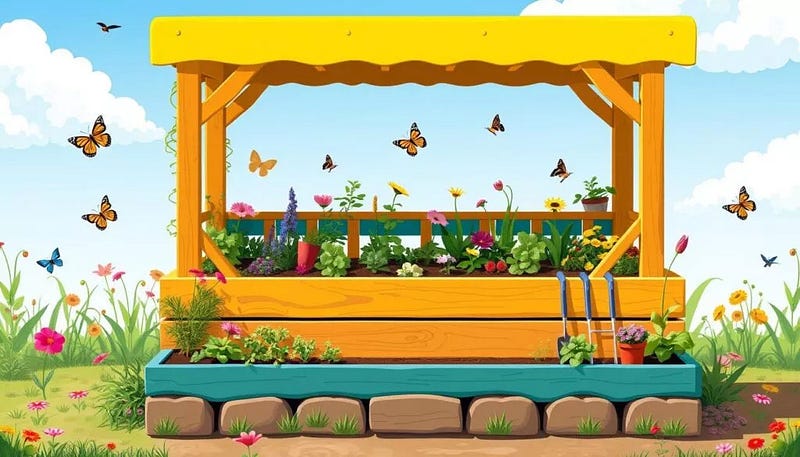
Self-Irrigation Systems in Accessible Garden Designs
Adding self-irrigation systems to garden designs is key for less upkeep and a better gardening experience. These systems cut down on watering needs. They let you enjoy the therapeutic side of gardening more.
The Green Circle Accessible Garden uses a 42-gallon water reservoir. This keeps plants moist without needing hoses or buckets.
The grow tray has a 10-inch soil depth and 40 drainage holes. These holes help plants grow by stopping water from staying too long. The system also uses 100 feet of wicking ropes to keep soil moist. This makes gardening fun for everyone, no matter their age or ability.
Accessible gardens with self-watering systems are more useful and effective. Gardening can make people stronger and more confident, especially when they can do things on their own. A self-watering system makes gardening easier and less tiring.
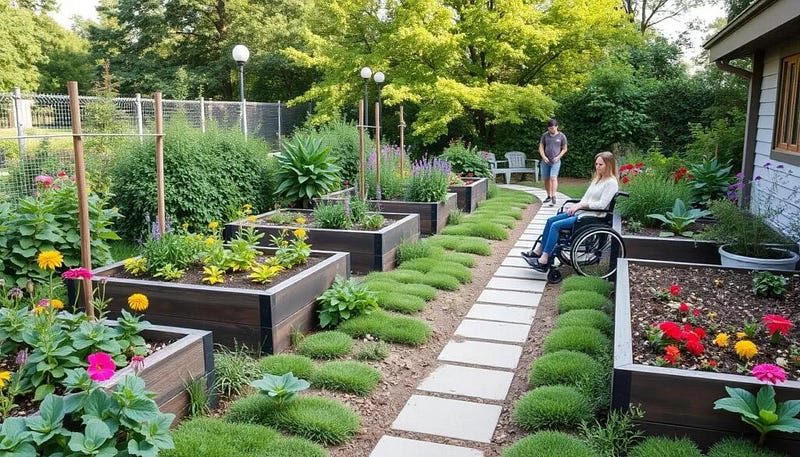
Gardening Tools and Accessories for All Abilities
Improving gardening for people with disabilities is key. The right tools and accessories can really help. You can change old tools and add furniture that’s comfy and useful.
Adapting Tools for Easier Use
Choosing ergonomic garden tools can help a lot. For example, the Five-Piece Ergonomic Garden Hand Tool Set by Radius Garden has short handles. This helps visually impaired people work closer to the soil. Tools like the Earthwise Cordless Rechargeable Shrub Shear and Hedge Trimmer Combo are light. This makes them easy to carry around for different tasks.
Tools like the Gardener’s Friend Ratchet Pruning Shears need less hand strength. This makes pruning easier for those with weak grip. You can also use PETA Easi-Grip Add-On Handles to make standard tools better. This makes gardening more comfortable.
Incorporating Accessible Garden Furniture
Having comfy and useful garden furniture helps you garden longer. The Vertex Garden Rocker Rolling Seat lets you lean forward. This makes it easy to reach plants. The Garden Kneeler and Seat supports up to 330 lbs and folds up for easy storage. It makes kneeling in the garden comfy.
Raised garden beds, like those 48x24x30 inches and holding 200 pounds, are great for wheelchair users. Making your garden setup better with these tools and accessories makes gardening fun for everyone.
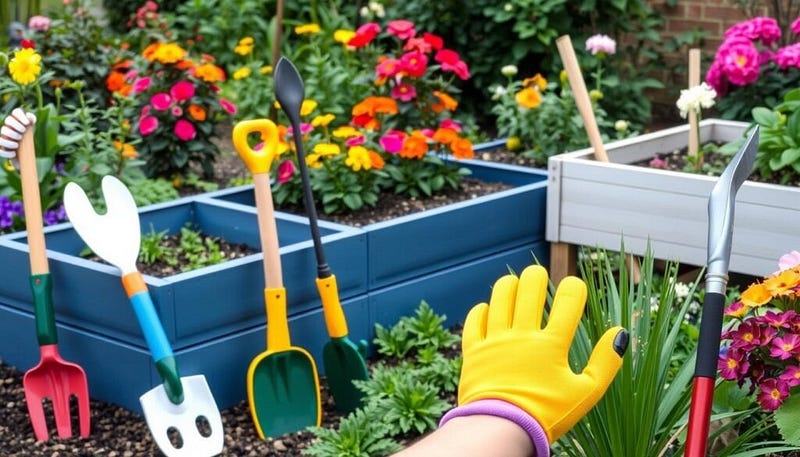
Creating a Sensory Garden Experience for Everyone
Creating a sensory garden is all about design that touches all five senses. It lets everyone enjoy nature’s wonders. Important parts include plants, water features, and sculptures. These make sure everyone, even those with mobility issues, can enjoy the garden.
Wide paths are crucial for easy walking. Different textures, colors, and smells in plants invite people to explore and have fun.
Accessibility is a big deal. Seating areas let people rest and socialize. They make the garden a welcoming place for everyone. Shelter from bad weather makes visits longer and more enjoyable. Also, having the right facilities means everyone can enjoy the garden without worries.
Using native plants is smart. They help local wildlife and need less care. This makes the garden sustainable and accessible. The mix of sensory elements leads to more interactions. It makes the experience richer for everyone, no matter their abilities.
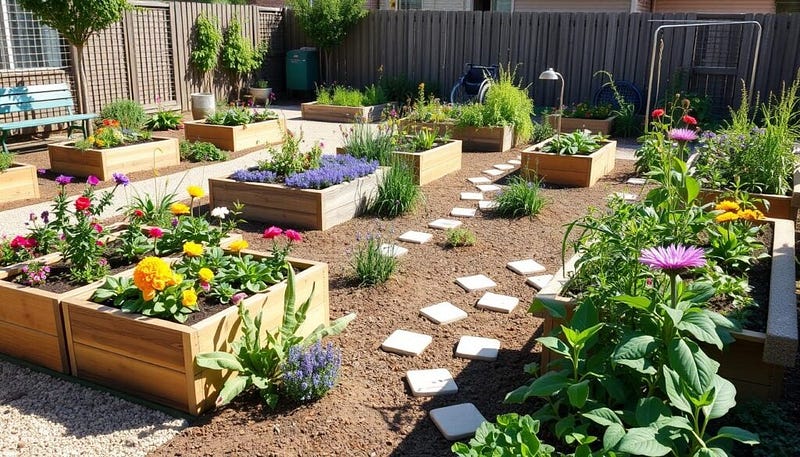
Promoting Inclusivity through Communal Gardening Projects
Communal gardening projects bring people together, no matter their age or ability. They offer a chance to work together and build friendships. Gardens are made accessible for everyone, with features like raised beds and paths for wheelchairs.
In towns like Ann Arbor, community gardens are making a difference. The Center for Independent Living’s Discovery Garden is affordable and accessible for many. The Chelsea Community Garden also offers plots at a low cost, making gardening available to all. Local sponsors help make these gardens possible, reducing costs for everyone.
Community gardens are more than just pretty spaces. They help solve food problems and are easy to get to by public transport. By involving everyone in planning, gardens become places where people feel they belong and can contribute.
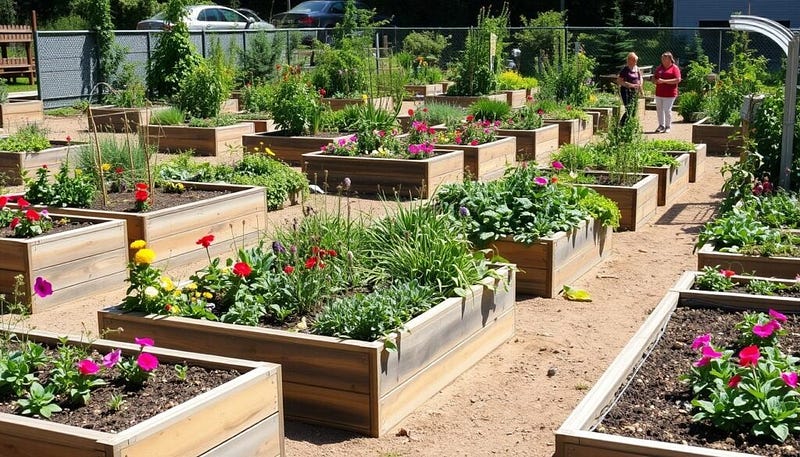
Real-Life Success Stories in Accessible Gardening
Accessible gardening has changed lives in many communities. For example, a new garden in Pullman is one of just two in the area. It started in 2020 with help from landscape architecture students. Now, it’s open thanks to groups like the Innovia Foundation and the Christopher & Diana Reeve Foundation.
People who garden find it very rewarding. Over 85% of wheelchair gardeners say it helps them relax and connect with nature. They feel more independent and healthy, thanks to gardening. About 60% say growing their own food is key to their health.
Many gardeners face challenges, like reaching plants. But, there are solutions. They use elevated beds and tall pots to make gardening easier. Raised beds made from railway sleepers and scaffold boards are also popular. They help gardeners with mobility issues grow plants without strain.
Support from the community is vital for gardening success. Over 80% of wheelchair gardeners enjoy the social side of gardening. They form friendships and help each other. This teamwork is shown in community gardens and adaptive tools for everyone. These stories show how gardening can empower and reconnect us with nature.

Tips for Parents: Engaging Your Kids in Accessible Gardening
Getting kids involved in gardening teaches them important skills and boosts their creativity. The Centers for Disease Control and Prevention say a disability affects how people interact with their world. Start by letting your kids help pick out plants they like.
Play games or do activities that focus on touch, smell, and color. These fun activities make gardening fun for all, especially kids with different needs. Make sure all kids can join in by using tools and equipment that fit them. This could mean wider paths, comfy seats, and beds that are easy to reach from a chair.

Teaching kids to love gardening can give them a lifelong love for nature. By making your garden welcoming, you show that gardening is more than a hobby. It’s a way to connect with the world around us. This approach makes gardening better for everyone.
Conclusion
Creating accessible garden beds for kids promotes inclusivity. It lets all children enjoy gardening. By using adaptable tools and raised beds, you make spaces for everyone.
Studies show that gardening lowers stress and boosts mood. This shows the mental health perks of gardening. Also, making gardens easy to use shows we value everyone’s ability to garden.
Gardening is good for our bodies and helps us feel connected. When we work together, we make gardening better for everyone. By creating welcoming spaces, we grow gardeners who value inclusivity and shared moments.
FAQs
What is a Kids Handicap Accessible Garden Bed?
A kids handicap accessible garden bed helps kids with mobility issues garden easily. It’s raised and has features that make it easy to use. This lets kids plant, care for, and pick their own food without getting tired.
What are the benefits of wheelchair accessible raised garden beds?
These beds make gardening fun for everyone, including those in wheelchairs. They help people get along better, feel better, and don’t get tired easily. This is good for their health.
What features should a wheelchair accessible garden bed have?
It should be easy to reach, wide enough for wheelchairs, and have supports for comfort. The surface should be safe and the bed should last through weather changes.
How can modular designs enhance gardening spaces?
Modular designs let you change your garden to fit your needs. You can adjust the height and layout to be creative and meet different gardening styles.
How do you create paths for wheelchair accessibility?
Paths should be wide, stable, and even. Use materials like concrete or crushed stone. Make sure they’re not slippery and have gentle slopes with handrails for hills.
What is the ideal height for building kids handicap accessible garden beds?
Raised beds for wheelchairs should be 24 to 36 inches high. They should be easy to reach from all sides without being too wide.
How do self-irrigation systems benefit accessible gardens?
Self-irrigation systems save time and keep the soil moist. They let gardeners enjoy their time outside without always watering by hand.
What types of gardening tools are suited for individuals with disabilities?
Tools for people with disabilities should be easy to use and light. They should have comfortable handles. This makes gardening more fun.
How do you create a sensory garden experience?
Choose plants that feel, smell, and look interesting. Sensory gardens should be fun for everyone, no matter their abilities.
How can communal gardening projects promote inclusivity?
Gardening together brings people of all ages and abilities together. It builds friendship, teamwork, and makes sure everyone can join in, no matter their mobility.
What are some real-life success stories in accessible gardening?
Many groups have started gardening projects that really help people with disabilities. These projects make people feel more independent, happy, and help them meet new friends.
How can parents engage their children in accessible gardening?
Parents can get kids involved by letting them help design the garden. Let them pick plants and add sensory elements. This teaches them important skills and helps them love gardening.



Comments
Post a Comment